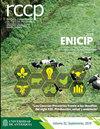Response of broilers to digestible sulfur amino acids and threonine intake: maximum economic return
IF 0.5
4区 农林科学
Q4 AGRICULTURE, DAIRY & ANIMAL SCIENCE
引用次数: 0
Abstract
Background: The determination of amino acid supplements for broiler chicken requirements based on performance does not always reflect maximum profitability. Objective: To estimate the optimal levels of digestible threonine (Thr) and sulfur amino acids (SAA) in diets for broilers based on an economic analysis. Methods: Two dose-response assays were conducted, and each assay was divided into three phases: initial (1-14 days), grower (15-28 days), and finisher (29-42 days). Five hundred and sixty male Cobb 500® broilers were randomly distributed to seven treatments with increasing levels of the amino acid (SAA or Thr), with four replicates and 20 birds each. Bodyweight gain (BWG) and feed intake (FI) were used to fit a segmented model. Gross income (GI), total feed costs (TFC) and gross margin (GM) were calculated based on local values. Results: Increasing levels of amino acid elicited a response in BWG and FI for all evaluated phases. The estimates for maximum profit based on GI and TFC were 223, 504, and 975 mg SAA/bird/d, and 236, 696, and 1,042 mg Thr/bird/d in starter, grower and finisher phases, respectively. Conclusion: Varying the AA prices affected only slightly the economic optimal intake of Thr and sulfur amino acids. Despite market fluctuations, the economic approach presented in this study demonstrates to be a helpful tool to choose the ideal inclusion level of amino acids in the feed.肉鸡对可消化硫氨基酸和苏氨酸摄入量的反应:最大经济回报
背景:以生产性能为基础确定肉鸡所需氨基酸添加量并不总是反映最大盈利能力。目的:通过经济分析,确定肉仔鸡饲粮中可消化苏氨酸(Thr)和含硫氨基酸(SAA)的最佳水平。方法:进行2次剂量反应试验,每次试验分为3个阶段:初始(1 ~ 14 d)、生长(15 ~ 28 d)和终成期(29 ~ 42 d)。选取560只雄性科布500®肉仔鸡,随机分为7组,每组4个重复,每个重复20只鸡,每组增加氨基酸(SAA或Thr)水平。采用增重(BWG)和采食量(FI)进行分段模型拟合。毛收入(GI)、饲料总成本(TFC)和毛利率(GM)根据当地值计算。结果:氨基酸水平的增加引起了BWG和FI在所有评估阶段的反应。在发酵期、生长期和育成期,基于GI和TFC的最大利润分别为223、504和975 mg SAA/bird/d, 236、696和1042 mg Thr/bird/d。结论:AA价格变化对苏、硫氨基酸经济最佳摄入量影响不大。尽管市场波动,但本研究提出的经济方法证明是选择饲料中理想氨基酸添加水平的有用工具。
本文章由计算机程序翻译,如有差异,请以英文原文为准。
求助全文
约1分钟内获得全文
求助全文
来源期刊

Revista Colombiana De Ciencias Pecuarias
AGRICULTURE, DAIRY & ANIMAL SCIENCE-
CiteScore
0.80
自引率
0.00%
发文量
18
审稿时长
6-12 weeks
期刊介绍:
The editors of Revista Colombiana de Ciencias Pecuarias (RCCP) welcome the submission of original manuscripts on experimental and clinical studies associated with the broad areas of animal sciences and veterinary medicine as they interface with biochemistry, molecular biology, physiology, pharmacology, toxicology, pathology, microbiology, parasitology, immunology and epidemiology. The scope of the journal includes studies of basic and applied research in animal management and production, feeding and nutrition, reproduction, breeding, genetics, animal welfare and behavior; as well as animal production focussed from biotechnology, soil science, agrostology, silvopastoral systems, livestock economics and the environment.
The criteria for acceptance of papers submitted for publication are originality, quality and clarity of the content. Each contribution must be based on original, unpublished research that has not been simultaneously submitted to other journals. All papers will be peer reviewed. All authors bear responsibility for ensuring the integrity and quality of their reported research. It is the author''s responsibility to secure permission to use figures or tables that have been published elsewhere.
Contributions may be classified as original research, review, rapid communication, clinical case studies or methodological articles, as well as news/commentaries or letters to the editor. Most review articles are invited by the editor. Authors interested in submitting a review article should contact the corresponding editor. Rapid publication of original manuscripts is a goal of the journal. Manuscripts must be written in English. Each manuscript is considered for publication with the understanding that it has not been simultaneously submitted to any other journal. Upon acceptance for publication, papers are subject to editorial review and revision.
 求助内容:
求助内容: 应助结果提醒方式:
应助结果提醒方式:


